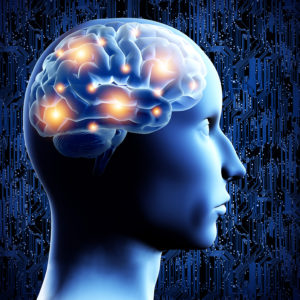 Current science has no explanation for subjective experience. There isn’t even an adequate definition of consciousness. Recent research continues many approaches in attempts to find a brain region that is correlated with basic awareness or consciousness. In order to proceed without definitions, study attempts to find simple awareness without specific content.
Current science has no explanation for subjective experience. There isn’t even an adequate definition of consciousness. Recent research continues many approaches in attempts to find a brain region that is correlated with basic awareness or consciousness. In order to proceed without definitions, study attempts to find simple awareness without specific content.
But, recent findings show that for most mental events, almost the entire brain is part of wide circuits signaling in milliseconds. No modules have been found, including modules for awareness. In fact, integration of all regions seems to be more relevant than modules. As someone slips into coma and anesthesia, modules appear when people are definitely not conscious. When aware, more widespread integration appears. This post describes efforts to answer the question—where is subjective experience in the brain.
How to Do Research
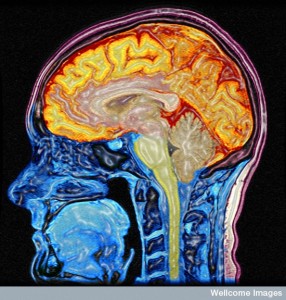 There has been no evidence of a center of the brain. Previous theories of what brain regions are necessary for consciousness did not pan out. An old disproven theory includes the frontal parietal region. Theories of gamma rays correlating with awareness are outmoded. But, the search continues in study of circuits, regions and brain waves. Perhaps brain waves in smaller regions may be relevant.
There has been no evidence of a center of the brain. Previous theories of what brain regions are necessary for consciousness did not pan out. An old disproven theory includes the frontal parietal region. Theories of gamma rays correlating with awareness are outmoded. But, the search continues in study of circuits, regions and brain waves. Perhaps brain waves in smaller regions may be relevant.
One way to start researching a question without a definition is to find minimum regions or circuits of brain that allow perception of any type or action that appears to have a purpose. With more ability to monitor the brain through imaging, many medical patients who cannot communicate or move (vegetative state) have been shown to be aware.
Recent research points to totally different regions than were considered before. Previously, evaluation and monitoring were intuitively considered important. But these do not seem to be necessary for simple awareness, but rather are part of a larger experience. It is possible that sensory regions are more primary, but this is not clear either.
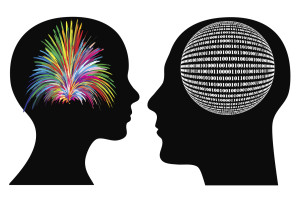 Perceptions have been described in previous posts. Surprisingly, more top down neurons modulate and determine results of sensory information than bottom up information input. The simplest part of having a perception of sound, sight, smell, or more complex emotions and thoughts, is just being awake and aware.
Perceptions have been described in previous posts. Surprisingly, more top down neurons modulate and determine results of sensory information than bottom up information input. The simplest part of having a perception of sound, sight, smell, or more complex emotions and thoughts, is just being awake and aware.
Brain regions for general awakeness are in midline brain. Previous theories of brain regions involved in awareness include cortex in the frontal and parietal regions. These also appear to be ancillary to the primary awareness. Gamma waves appear to be related to attention, not basic awareness. Recently, new research is finding other possible regions by studying vision and hearing.
To study seeing and hearing, subjects usually must answer questions about their ability to understand events. In the brain damage called blindsight, subjects might answer visual questions without being “aware” that they know what they are observing. Other ways to question subjects include scales where they note how certain they are of a particular observation. All of this involves subjectivity. The trick is trying to make objective observations out of subjectivity.
Content Versus Awareness
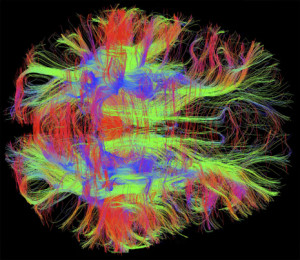 To determine content, specific neuronal circuits are studied.
To determine content, specific neuronal circuits are studied.
Some neurons are involved in specifying particular aspects of a perception – Type 1 neurons. This can be studied in part by stimulating specific neurons to see if they triggers colors, views, faces or other aspects of perception.
Other neurons—Type 2—appear to be related to the full experience without the details that are received from the other types of neurons. These neurons combine all the details from many neurons. Other centers allow both types to exist, such as supplying energy to neurons. These background centers provide the ability to perceive, without any content or experience.
Content Type 1 Neurons
 Studies compare activity with and without specific content, attempting to keep other variables the same. This is not easy. Many studies have included vision, such as presenting different stimuli to the right and left eye and studying which neurons fire. Many other types of studies are involved.
Studies compare activity with and without specific content, attempting to keep other variables the same. This is not easy. Many studies have included vision, such as presenting different stimuli to the right and left eye and studying which neurons fire. Many other types of studies are involved.
As a whole, these have identified neuronal networks in the frontal and parietal regions. These circuits are involved in measuring vision and movement tasks with stimuli that are real and not invisible. This research identifies many other factors that are not specifically regions for understanding perceptions. These factors are attention, distraction, planning and unconscious reactions. Complex research tries to get rid of each of these confounding variables to find the single conscious spot. Another problem with all of these studies is they involve subjective reports.
To try to identify Type 2 regions that pull an experience together, other study techniques are used. These compare general awareness with sleep, anesthesia and coma. These same regions in the frontal and parietal regions seem to be correlated in this research. But, these regions also are part of various levels of attention.
Comparing REM and Non REM sleep have been used to try to differentiate centers. These studies focus on different regions near the intersection of temporal, parietal and occipital regions for perceptions and a different frontal region for thoughts. Specific high frequency brain waves appear to be associated with specific experiences during dreaming, including visual information, movement and speech.
A region in the posterior brain is the focus of a number of these studies and is the same found in Type 1 centers. This posterior region has therefore become a focus of the search for neuronal centers related to conscious experience of a perception.
Brain Regions

There are many brain regions that don’t directly contribute to experience of specific subjective content. Damage to the large cerebellum doesn’t affect perception experiences much, if at all. Recently, a woman in China was identified who had no cerebellum at all. With neuroplasticity, she was fairly normal until adulthood, when it was randomly noted in a physical examination.
Brainstem damage is devastating to all experience. It appears that brainstem and hypothalamus are background regions necessary for subjective experience, but not involved in awareness, the content or experience. Even subcortical regions that modulate content are not really necessary in sleep.
Many regions determine emotional states, but aren’t the experience of an emotion. Basal ganglia damage decreases motivation and emotion. But even with extensive damage and some cognitive deficits, patients can be aware with subjective experience. Another region under the insula cortex has been studied for its relation to subjective experience. Several case reports of damage to this area have conflicting results and one had awareness and subjective experience.
Thalamus integrates sensory data. Studies show lesions cause decreased motor ability and poor communication. They can cause coma or not and they have conflicting results about awareness. There doesn’t seem to be a direct correlation with the content of awareness.
 Studies of cortex regions are complex. Primary visual regions appear to be related to identification of visual stimuli, not its content. Higher regions co relate to the content not the stimulus.
Studies of cortex regions are complex. Primary visual regions appear to be related to identification of visual stimuli, not its content. Higher regions co relate to the content not the stimulus.
Studies show inconsistent results in the primary visual region (V1). Lesions in V1 produce unconscious awareness of vision called blindsight. They perform as if they see it but don’t have the experience of seeing it. Other lesions show that V1 is not sufficient for conscious perception of sights. Other primary sensory regions for touch and hearing have not had extensive research.
Another theory is that frontal cortex is related to conscious perception and dorsal unconscious and with movements. But, research shows that both are necessary for visual subjective awareness. Findings about the frontal parietal cortex are inconsistent. Consciousness doesn’t need a frontal lobe. Even lobectomies don’t stop subjective experience. Other lesions in the frontal region leave subjective experience, while affecting particular cognitive abilities. (see post on frontal lobe).
Posterior Cortex
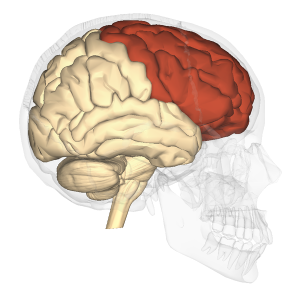
Studies of loss of consciousness find the posterior medial cortex most correlated with awareness.
Studies of posterior cortex of several types relate it to subjective experience of content. Some provide stimuli and see relations of expectations and performance. Sleep studies also point to this region. During dreaming, frontal activity is low compared to awake states. fMRI studies show activity in these regions that correlate with visual stimuli as well. Electrical stimulation of brain regions also shows triggering of specific experiences with posterior cortex. These include faces and wanting to move.
Neuronal responses of scenes and people rapidly travel through many brain regions (in 100 milliseconds). This includes multiple parts of the cortex visual systems. It also includes more top down neurons related to perception. These complex feedback circuits appear to be necessary for subjective experience.
Are Particular Neurons Involved?
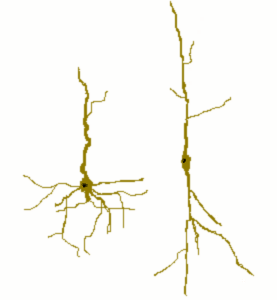
There have been suggestions that particular large neurons (von Economo neurons) in cortex layer 5 are related to subjective experience. These neurons are also called spindle neurons. But, recent studies show that these may be more related to unconscious behavior.
Thin tufted pyramidal cells in layer 5A and 6 are connected heavily to many cortical regions. Even more connected are supra granular pyramidal neurons, with many feedback connections. These neurons also have a unique spontaneous activity (called neuronal avalanches) that could relate to integration of experience content. In animals, this region is correlated with sensory awareness.
Brain Waves and Evoked Potentials
 For some time, gamma waves in visual cortex have been thought to be related to subjective awareness in vision. Waves were thought to bind details to an experience with synchronous oscillations in the gamma range. More recent studies show high frequency gamma waves more related to attention and middle range to whether the stimulus is seen or not. Gamma waves occur in NREM sleep, anesthesia, seizures and unconscious experience. This new data shows gamma waves are not necessary for visual experience and are not correlated with awareness.
For some time, gamma waves in visual cortex have been thought to be related to subjective awareness in vision. Waves were thought to bind details to an experience with synchronous oscillations in the gamma range. More recent studies show high frequency gamma waves more related to attention and middle range to whether the stimulus is seen or not. Gamma waves occur in NREM sleep, anesthesia, seizures and unconscious experience. This new data shows gamma waves are not necessary for visual experience and are not correlated with awareness.
Evoked potentials are another way to study brain responses. Another possible marker of consciousness was thought to be a particular evoked potential. P3b occurs 300 milliseconds after a stimulus of sight or hearing. More recent data show some subjective content do not trigger it and sometimes it is triggered without content. Conscious patients with damaged brains don’t have it. 40% of coma patients have it. Findings are not at all consistent.
Recently, another evoked potential has emerged as possibly related. This is 100 milliseconds after a stimulus and is in the same posterior cortex region as the other possible candidates.
 Another finding on EEG is also being studied. This is called activated or desynchronized EEG and occurs during attention. It consists of low voltage fast activity and deep sleep’s high voltage slow activity. Loss of consciousness occurs at the same time as thalamic switching from tonic to bursts of firing.
Another finding on EEG is also being studied. This is called activated or desynchronized EEG and occurs during attention. It consists of low voltage fast activity and deep sleep’s high voltage slow activity. Loss of consciousness occurs at the same time as thalamic switching from tonic to bursts of firing.
Slow waves are related to cortex switching on and off up and down states. Those subcortical brain regions changes occur with decrease of activating systems. High amplitude slow waves are related to loss of consciousness. Changes in the waves occur in transition from coma to barely conscious and then awake causing delta to theta to alpha. But, it is not clear this reflects awareness. Slow waves can occur in conscious people in epilepsy.
Previous studies have tried to correlate whole brain recordings to consciousness. But, local patterns may be more relevant. Sleep cortex can be activated while whole brain EEGs have only slow waves. Local activation in the parietal occipital region is related to visual dreams and then awakening.
Recent EEG studies show that there are many possible local events in conscious people. There are fewer variations when unconscious. Also consciousness might involve more integrated states rather than different modules with various activities.
Where is Subjective Experience in the Brain?
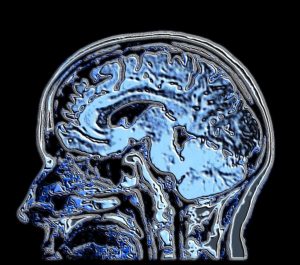 Most current approaches to finding places in the brain related to consciousness or awareness do not corroborate old theories of networks in the frontal parietal regions. Recent research is focused on activity in a much more narrow region near the overlap of the temporal-parietal-occipital regions. Some of these appear to be triggered by content of awareness—such as faces. The older larger circuits appear related to attention focused on particular areas, not simple awareness.
Most current approaches to finding places in the brain related to consciousness or awareness do not corroborate old theories of networks in the frontal parietal regions. Recent research is focused on activity in a much more narrow region near the overlap of the temporal-parietal-occipital regions. Some of these appear to be triggered by content of awareness—such as faces. The older larger circuits appear related to attention focused on particular areas, not simple awareness.
In fact, most regions of the brain have something to do with awareness and consciousness, but this doesn’t qualify them as a location of consciousness.
There is still no understanding of how subjective experience binds together all that is part of our daily experience of awareness. Most events in the brain involve large brain wide circuits traversed in milliseconds. Just this week, a study implied meaning of words is not in a language center, but distributed throughout the entire brain. The same is true for memory, which appears to be very distributed.
Some pre frontal regions are related to experiences of various types. Default mode circuits appear to be related to day dreaming and identity, not simple awareness. Other similar frontal regions have nothing directly to do with consciousness. With so much top-down effects in perception, it is not clear how much sensory regions contribute to simple awareness. Brainstem reticular formation and parts of the thalamus help create the necessary activation of circuits for awareness but are not awareness per se.
No brain region simply reflects consciousness. Some regions are correlated with content of awareness. For now, this search will continue with no definition of consciousness or subjective experience. We are left with our every day experience.